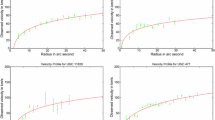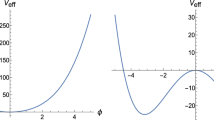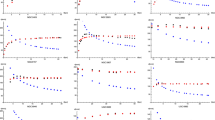Abstract
Bose–Einstein condensate dark matter model and Randall–Sundrum type 2 brane-world theory are tested with galactic rotation curves. Analytical expressions are derived for the rotational velocities of test particles around the galactic center in both cases. The velocity profiles are fitted to the observed rotation curve data of high surface brightness and low surface brightness galaxies. The brane-world model fits better the rotation curves with asymptotically flat behaviour.
Access provided by Autonomous University of Puebla. Download conference paper PDF
Similar content being viewed by others
Keywords
- Galactic Rotation Curve
- Dark Matter
- Randall-Sundrum Type
- High Surface Brightness (HSB)
- Bose-Einstein Condensation (BEC)
These keywords were added by machine and not by the authors. This process is experimental and the keywords may be updated as the learning algorithm improves.
1 Introduction
Luminous matter alone can not explain the observed behaviour of the galactic rotation curves and an invisible, dark matter component is needed [1]. One possibility to explain dark matter is to introduce collisionless dark scalar particles in the form of a Bose–Einstein condensate (BEC) [2, 3]. However, up to now the evidence for dark matter has been only found by its gravitational interaction. It cannot be excluded that general relativity breaks down at scales of galaxies and beyond. Therefore several modified gravity models have been proposed to replace dark matter [4–6]. The Weyl fluid appearing in Randall–Sundrum type 2 (RS2) brane-world models can behave as an effective source for gravity and it is able to replace dark matter in galactic dynamics [7, 8].
We investigate here galactic rotation curves in RS2 brane-world and the BEC model for high surface brightness (HSB) and low surface brightness (LSB) galaxies.
2 The Baryonic Matter
Distribution of baryonic matter in HSB galaxies is described as the sum of a thin stellar disk and a spherically symmetric bulge component.
We assume that the mass distribution of bulge component with radius \(r_{bulge}\) follows the de-projected luminosity distribution with a factor called mass-to-light ratio \(\sigma \). The surface brightness profile of the spheroidal bulge is described by a generalized Sérsic function [9]: \(I_{bulge}(r)=I_{0,bulge}\exp \left[ -\left( r/r_{0}\right) ^{1/n}\right] \), where \(I_{0,bulge}\) and \(r_{0}\) are the central surface brightness and the characteristic radius of the bulge, respectively, and \(n\) is the shape parameter of the magnitude-radius curve. The contribution to the rotational velocity is
with gravitational constant \(G\) and mass of the bulge \(M_{bulge}(r)=\sigma I_{bulge}(r)\) within the radius \(r\) projected on the sky.
In a spiral galaxy the radial surface brightness profile of the disk decreases exponentially with the radius [10]: \(I_{disk}(r)=I_{0,disk}\exp \left( -r/h\right) ,\) where \(I_{0,disk}\) is the disk central surface brightness and \(h\) is a characteristic disk length scale. The contribution of the disk to the circular velocity is [10]:
where \(x=r/h\) and \(M_{disk}\) is the total mass of the disk. The functions \(I_{m}\) and \(K_{m}\) are the modified Bessel functions of the first and second kind with order \(m\), respectively. The Bessel functions are evaluated at \(x/2\).
The best fitting values of \(I_{0,bulge},n,r_{0},r_{bulge},I_{0,disk}\) and \(h\) are derived from the available photometric data. In case of LSB galaxies the baryonic model only consists of a thin stellar disk component which is the same as for the HSB galaxies.
3 Models for the Dark Matter Component
The mass density distribution of the static gravitationally bounded Bose–Einstein condensate is described by the Lane–Emden equation. An analytical solution for dark matter BEC was obtained in Ref. [3]: \(\rho _{BEC}(r) =\rho _{BEC}^{(c)} \left( \sin (kr)/kr\right) \), where \(k=\sqrt{Gm^{3}/\hbar ^{2}a}\) and \(\rho _{BEC}^{(c)}\) is the central mass density of the condensate. The mass profile of the galactic halo is \(m_{BEC}\left( r\right) =4\pi \int \rho _{BEC}(r)r^{2}dr\) giving the following contribution to the rotational velocity [3]:
In RS2 brane-world theory the 4-dimensional effective Einstein equation has extra source terms, which arise from the embedding of the 3-brane in the bulk [11]. We assume that the brane embedding is \(Z_{2}\)-symmetric and there is no matter in the 5-dimensional spacetime but there is a cosmological constant. Nevertheless the effect of the brane cosmological constant arising from the brane tension and the 5-dimensional cosmological constant is neglected at the scales of galaxies. Then at low energies there is only one extra source term in the effective Einstein equation arising from the 5-dimensional Weyl curvature, which acts as a fluid (the Weyl fluid). The contribution to the rotational velocity in a Post-Newtonian approximation is derived in [8]:
with constants \(\alpha \), \(\beta \), C and \(M_{0}^{tot}\) charaterizing the Weyl fluid and velocity of light \(c\). A scaling constant \(r_{b}\) was introduced such that C becomes dimensionless and \(r_{b}=r_{bulge}\) was chosen. The rotational velocity (4) is valid for any \(r\) \(>r^{*}\), where \(r^{*}\) represents the radius beyond which the baryonic matter does not extend. We assume that (i) the contribution of the Weyl fluid can be neglected within the bulge radius, and (ii) the observed rotation curves within \(r_{bulge}\) can be explained with baryonic matter alone (it is given by the sum of (1) and (2) for HSB and by (2) for LSB galaxies). Outside \(r_{bulge}\) we assume the effects of the disk can be handled as perturbation, therefore the rotational curves are generated by the sum of (2) and (4).
The best fit rotational curves of the Weyl and BEC models for the observed velocity profiles of the HSB galaxy ESO445G19 and the LSB galaxy NGC3274 are shown in Fig. 1.
Best fit curves for the observed velocity profiles of the HSB galaxy ESO445G19 and the LSB galaxy NGC3274. The solid black and dashed red curves show the BEC and Weyl models, respectively. In case of HSB galaxy, the shape of the curve near the center where baryonic matter dominates is determined by the photometric data
4 Concluding Remarks
We investigated whether RS2 brane-world and Bose–Einstein condensate dark matter models can explain the galactic rotational curves. Analytical expressions for the rotational velocity of a test particle around the galactic center in both model scenarios were derived. The rotation curves can be well-explained by both models and we represented this for both HSB and LSB galaxies in Fig. 1. The Weyl model was confronted with a larger galaxy sample, finding good agrement with the observations in [8].
References
Persic, M., Salucci, P., Stel, F.: The universal rotation curve of spiral galaxies—I. The dark matter connection. Mon. Not. R. Astron. Soc. 281, 27 (1996)
Sin, S.: Late-time phase transition and the galactic halo as a Bose liquid. Phys. Rev. D 50, 3650 (1994). doi:10.1103/PhysRevD.50.3650
Böhmer, C., Harko, T.: Can dark matter be a Bose-Einstein condensate? J. Cosmol. Astropart. Phys. 2007(06), 025 (2007). doi:10.1088/1475-7516/2007/06/025
Milgrom, M.: A modification of the Newtonian dynamics as a possible alternative to the hidden mass hypothesis. Astrophys. J. 270, 365 (1983). doi:10.1086/161130
Sanders, R.: Anti-gravity and galaxy rotation curves. Astron. Astrophys. 136, L21 (1984)
Roberts, M.: Galactic metrics. Gen. Rel. Grav. 36, 2423 (2004). doi:10.1023/B:GERG.0000046830.85831.4a
Mak, M., Harko, T.: Can the galactic rotation curves be explained in brane world models? Phys. Rev. D. 70, 024010 (2004). doi:10.1103/PhysRevD.70.024010
Gergely, L., Harko, T., Dwornik, M., Kupi, G., Keresztes, Z.: Galactic rotation curves in brane world models. Mon. Not. R. Astron. Soc. 415, 3275 (2011). doi:10.1111/j.1365-2966.2011.18941.x
Sérsic, J.: Atlas de Galaxias Australes. Observatorio Astronomico, Universidad Nacional de Córdoba, Córdoba (1968)
Freeman, K.: On the disks of spiral and so galaxies. Astrophys. J. 160, 811 (1970). doi:10.1086/150474
Shiromizu, T., Maeda, K.I., Sasaki, M.: The Einstein equations on the 3-brane world. Phys. Rev. D. 62, 024012 (2000). doi:10.1103/PhysRevD.62.024012
Author information
Authors and Affiliations
Corresponding author
Editor information
Editors and Affiliations
Rights and permissions
Copyright information
© 2014 Springer International Publishing Switzerland
About this paper
Cite this paper
Dwornik, M., Keresztes, Z., Gergely, L.Á. (2014). Modified Gravity Theories and Dark Matter Models Tested by Galactic Rotation Curves. In: Bičák, J., Ledvinka, T. (eds) Relativity and Gravitation. Springer Proceedings in Physics, vol 157. Springer, Cham. https://doi.org/10.1007/978-3-319-06761-2_59
Download citation
DOI: https://doi.org/10.1007/978-3-319-06761-2_59
Published:
Publisher Name: Springer, Cham
Print ISBN: 978-3-319-06760-5
Online ISBN: 978-3-319-06761-2
eBook Packages: Physics and AstronomyPhysics and Astronomy (R0)





